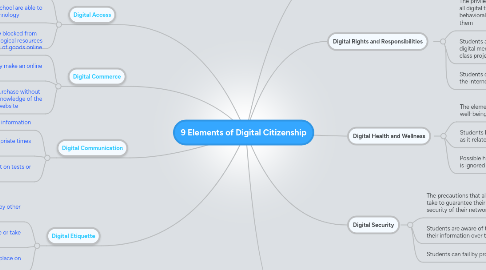9 Elements of Digital Citizenship
by Rebecca S.

1. Digital Commerce
1.1. The buying and selling of goods online
1.2. People know how to safely make an online purchase
1.3. People make an online purchase without any type of research or knowledge of the persons involved or the website
2. Digital Communication
2.1. The electronic exchange of information
2.2. People use technology at appropriate times in acceptable ways
2.3. People use technology to cheat on tests or harass others
3. Digital Etiquette
3.1. The standards of conduct expected by other technology users
3.2. A person goes to a private area to make or take a phone call
3.3. A person talks very loudly in a public place on their phone
4. Digital Access
4.1. Full electronic participation in society
4.2. All students in a school are able to use the same technology
4.3. Students are somehow blocked from using different technological resources
5. Digital Health and Wellness
5.1. The elements of physical and psychological well-being related to digital technology use
5.2. Students learn about the health and wellness as it relates to technology
5.3. Possible harmful physical effects of technology is ignored
6. Digital Law
6.1. The legal rights and restrictions governing technology use
6.2. downloading free music on an I Pod or on a computer
6.3. taking a picture and putting it on the internet
7. Digital Security
7.1. The precautions that all technology users must take to guarantee their personal safety and the security of their network
7.2. Students are aware of the dangers of providing their information over the internet
7.3. Students can fail by protecting their identity
8. Digital Rights and Responsibilities
8.1. The privileges and freedoms extended to all digital technology users, and the behavioral expectations that come with them
8.2. Students are able to cite web sites and other digital media sources using information for class projects
8.3. Students don't properly cite sources from using the internet
9. Digital Literacy
9.1. The capability to use the digital technology and knowing when and how to use it
9.2. Students can use digital technologies in new kind of ways
9.3. Students are provided with resources, materials that they cannot access away from this classroom


